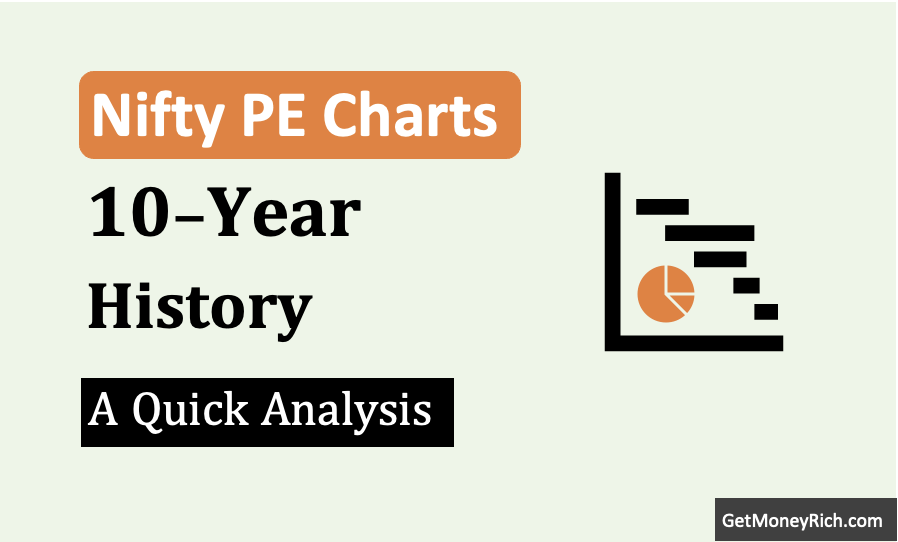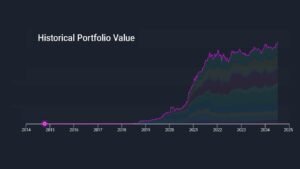Nifty 50 Index P/E History [2014 to 2015]
- Current P/E: 20.52
- PE (3-Yr Average): 21.9
- Remark: PE looks slightly undervalued
The Nifty 50’s PE ratio, starting from early 2014, exhibits a generally upward trend until 2019, (check the above chart). The historical PE data of Nifty 50 index reveals a steady rise, reaching levels around 28-30 by the end of 2019. This suggests a period of sustained earnings growth and increasing investor confidence in the Indian market’s leading companies.
Low interest rates, rising corporate profitability, and positive macroeconomic sentiment likely contributed to this expansion in valuation multiples. The above price chart also seems to corroborate this growth, trending higher in a smooth, steady manner.
The sharp PE spike observed in 2020 (visible very prominently in the chart), peaking at nearly 40, is directly attributable to the COVID-19 pandemic’s disruptive impact on corporate earnings. The data reflects a dramatic fall in profits across key sectors. This pushed the index PE to unsustainable levels despite the government initiatives. Subsequently, a correction occurred as the economy recovered and earnings rebounded.
I’ve seen this pattern of initial panic followed by a recovery play out several times in different crises.
From 2021 onwards, the Nifty 50’s PE gradually normalizes (check graph, its very visible). Through 2023 and early 2024, the index’s P/E ratio stabilizes to the range between 22 and 24.
However, the P/E ratio is slowly declining in the second half of year 2024. Early readings from 2025 also show that the decline in P/E ratio may be sustained.
This stabilization points to a more balanced market, where valuations are more closely aligned with underlying earnings potential.
Nifty 100 Index P/E History [2014 to 2015]

- Current P/E: 20.76
- PE (3-Yr Average): 22.4
- Remark: PE looks slightly undervalued
The Nifty 100’s PE chart offers a compelling view of market sentiment and valuation trends.
The early period from 2014 to 2017 shows a gradual increase in the PE ratio. It climbed from around 17.5 to roughly 27, suggesting steady earnings growth and positive investor sentiment driving the market.
As seen in the chart, This was a period of relatively stable economic growth, likely contributing to the consistent upward trend. The Nifty 100 PE data provides insight to consistent growth.
The period between 2018 and early 2020 displays a more range-bound PE. It was fluctuating between approximately 26 and 30. This could indicate a market digesting earlier gains and a period of consolidation. It was a period which was marked by uncertainty around global trade and economic growth.
The spike during the COVID-19 pandemic in 2020 is clearly visible in the chart. The PE soared to over 40 as earnings contracted sharply. This highlights the significant impact of unforeseen events on market valuations. The swift correction and subsequent decline in PE through 2021-2022 reflect a strong earnings rebound and a return to more normalized valuations.
Looking at 2023 and early 2024, the PE appears to stabilize and fluctuate around the low-20s. By historical standards, it represent a fair valuation for the index.
While there is an increase in PE at the start of 2024, it does not appear sustainable. Early 2025 shows that the P/E ratio may be correcting again to the low-20s.
Nifty Mid Cap 100 Index P/E History [2014 to 2015]

- Current P/E: 34.41
- PE (3-Yr Average): 28.4
- Remark: PE still looks overvalued
The Nifty Midcap 100’s PE ratio from 2014 reveals a measured journey compared to its small-cap cousin.
The index started 2014 with a PE around 14.3. Then it saw a steady increase to around 19 by mid of 2014. A gradual but consistent rise in PE through 2014 and 2015 indicates growing investor confidence and increasing valuations. The rise in PE is a reflection of improving profitability and growth prospects for the constituent companies.
The period from 2016 to 2019 displays a cyclical pattern within a narrower range, generally between 23 and 38. It is a period of relative stability. This suggests that the midcap segment was consolidating its growth, with earnings and valuations moving in tandem.
The COVID-19 pandemic in 2020 caused a sharp spike in the PE ratio. A similar thing happened to other indices as well. The rise in PE was due to the initial contraction in earnings. However, the recovery was swift, with the PE normalizing as earnings rebounded.
The midcap index displayed greater resilience (than the small cap index) during this period. It was indicative of its relatively stronger fundamentals compared to small caps. This resilience makes the midcap segment an attractive option for investors seeking growth with a degree of safety.
The period from 2021 onwards reveals a stabilization and subsequent decline in PE ratios. It suggests a more realistic valuation environment. We see a gradual decline in PE ratios through 2022 and early 2023, potentially creating attractive investment opportunities for those looking at long-term value.
In the second half of 2023 there is a gradual rise in PE. The steady rise continued till the first half of 2024. After that it started stabilizing again.
Early 2025 is showing a downward trend in PE.
Nifty Small Cap 100 Index P/E History [2014 to 2015]

- Current P/E: 27.52
- PE (3-Yr Average): 24.2
- Remark: PE still looks overvalued
The small caps offer both incredible opportunities and significant risks.
Analyzing the Nifty Small Cap 100’s PE ratio from 2014 paints a fascinating picture. Starting in early 2014 with a relatively high PE around 43. It then gradually decreased to a low of around 18 by mid-2014, suggesting improving earnings growth relative to price.
The index then saw a massive run-up in valuations through 2015. The peak was at a sky-high PE of 80, indicating a potentially overvalued market. This was followed by a sharp correction. It brought the PE back to more sustainable levels. This period highlights the inherent volatility in small caps and the importance of valuation discipline.
The subsequent years show a cyclical pattern, with periods of PE expansion followed by contraction. Notably, 2020 witnessed a significant PE spike due to the pandemic-induced earnings fall. But soon there was a recovery.
We then see a steady decline in PE through 2022, reaching what seems like an attractive valuation territory.
In 2023 the PE started increasing again, followed by a consolidation in year 2024.
Early 2025 shows a declining PE, which could be an early sign of correction.






